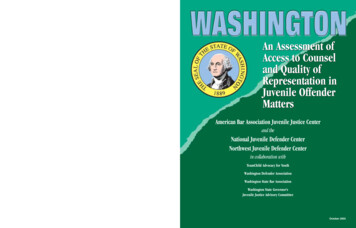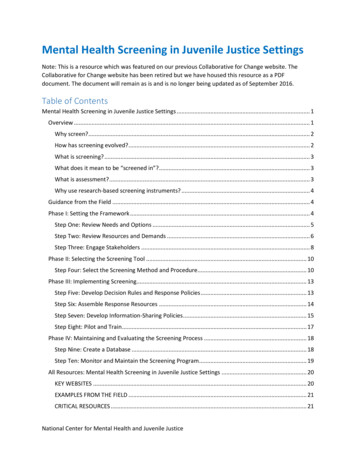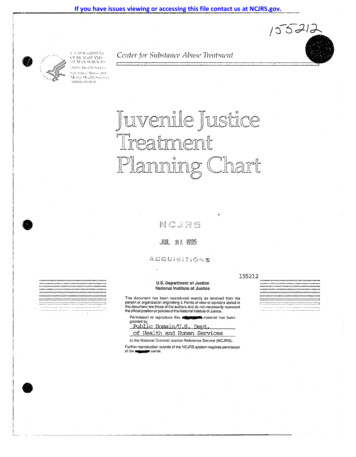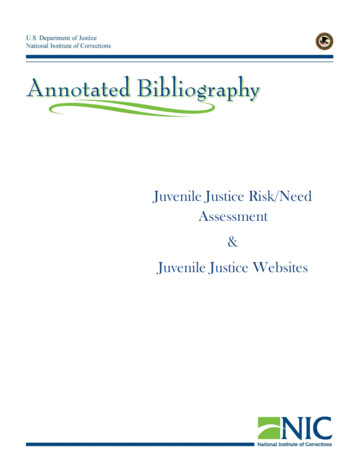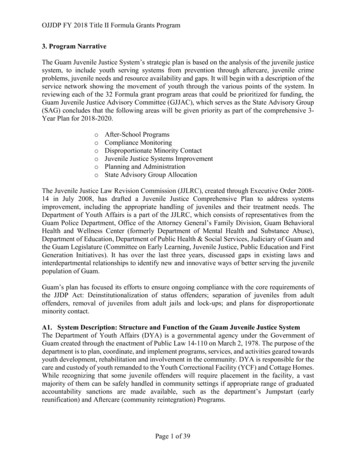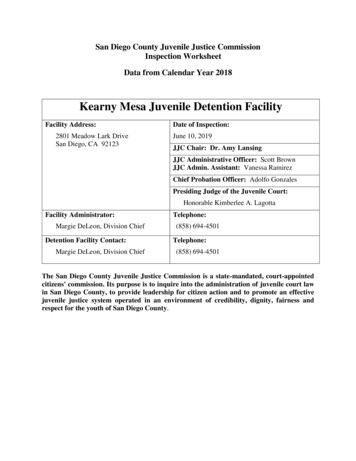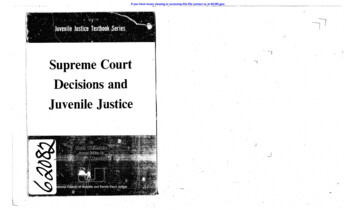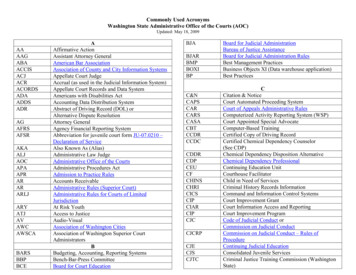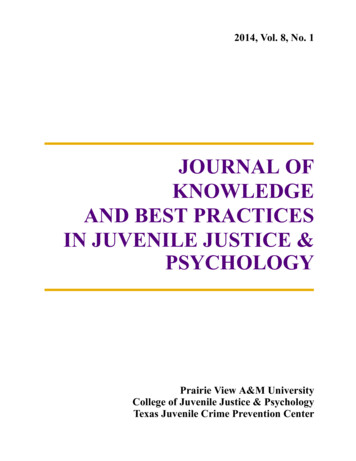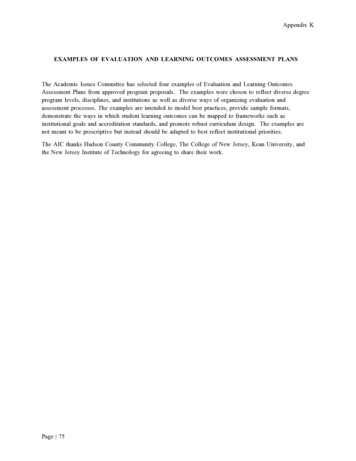
Transcription
SG OVCRAMSDEPANBJ A C EIOF FOffice of Justice ProgramsNT OFJUMESRTCETIU.S. Department of JusticeIJBJ OO F OJJ D PRJ US T I C E POffice of Juvenile Justice and Delinquency PreventionG uide forNT OFJUMESRTNBJ A C EIOF FSG OVCRAMSCETIImplementing theComprehensiveStrategy forSerious, Violent, andChronic JuvenileOffendersDEPAENGTHENING COMMUES BALANCED APPROACH FAMILY STREISING PROGRAMS EFFEMENT IMMEDIATE INTERVENTION PROMISAMS PEER GROUPS CRIME REDUCTION JUVENILE JUSTICE SYSTONS RISK ASSESSMENTUENCY PREVENTION GRADUATED SANCTIO CONTINUUMFICATION RISK FACTORS PROTECTIVE FACTORSFENGTHENING COMMUES BALANCED APPROACH FAMILY STREISING PROGRAMS EFFEMENT IMMEDIATE INTERVENTION PROMISAMS PEER GROUPS CRIME REDUCTION JUVENILE JUSTICE SYSTONS RISK ASSESSMENTUENCY PREVENTION GRADUATED SANCTIO CONTINUUMFFICATION RISK FACTORS PROTECTIVE FACTORSENGTHENING COMMUES BALANCED APPROACH FAMILY STREISING PROGRAMS EFFEMENT IMMEDIATE INTERVENTION PROMISAMS PEER GROUPS CRIME REDUCTION JUVENILE JUSTICE SYSTONS RISK ASSESSMENTUENCY PREVENTION GRADUATED SANCTIO CONTINUUMFICATION RISK FACTORS PROTECTIVE FACTORSFENGTHENING COMMUES BALANCED APPROACH FAMILY STREISING PROGRAMS EFFEMENT IMMEDIATE INTERVENTION PROMISAMS PEER GROUPS CRIME REDUCTION JUVENILE JUSTICE SYSTONS RISK ASSESSMENTUENCY PREVENTION GRADUATED SANCTIO CONTINUUMFICATION RISK FACTORS PROTECTIVE FACTORSFENGTHENING COMMUES BALANCED APPROACH FAMILY STREISING PROGRAMS EFFEMENT IMMEDIATE INTERVENTION PROMISAMS PEER GROUPS CRIME REDUCTION JUVENILE JUSTICE SYSTONS RISK ASSESSMENTUENCY PREVENTION GRADUATED SANCTIO CONTINUUMFICATION RISK FACTORS PROTECTIVE FACTORSFENGTHENING COMMUES BALANCED APPROACH FAMILY STREISING PROGRAMS EFFEMENT IMMEDIATE INTERVENTION PROMISAMS PEER GROUPS CRIME REDUCTION JUVENILE JUSTICE SYSTONS RISK ASSESSMENTUENCY PREVENTION GRADUATED SANCTIO CONTINUUMFICATION RISK FACTORS PROTECTIVE FACTORSFENGTHENING COMMUES BALANCED APPROACH FAMILY STREIJBJ OO F OJJ D PRJ US T I C E P
Guide for Implementingthe Comprehensive Strategyfor Serious, Violent, andChronic Juvenile OffendersNational Council on Crime andDelinquencyDevelopmental Research andPrograms, Inc.Barry KrisbergDavid OnekRichard WiebushElliott CurrieChristopher BairdGreg PearceJ. David HawkinsRichard F. CatalanoDevon D. BrewerHolly J. NeckermanSherry WongPat ChappellEditorJames C. Howell, DirectorResearch and Program Development DivisionOffice of Juvenile Justice and Delinquency PreventionShay Bilchik, AdministratorOffice of Juvenile Justice and Delinquency PreventionMay 1995i
The Office of Juvenile Justice and Delinquency Prevention is a component of the Officeof Justice Programs, which also includes the Bureau of Justice Assistance, the Bureau ofJustice Statistics, the National Institute of Justice, and the Office for Victims of Crime.ii
Table of ContentsList of Figures and Tables . viiiForeword . ixPreface . xiAcknowledgments . xiiiIntroduction . 1Arrest Trends . 1Victimization . 1Chronic, Serious, and Violent Career Patterns . 2New Research on Serious, Violent, and Chronic Juvenile Offenders . 3Violent Careers. 3Age of Onset . 3Chronic Offending . 4Prevalence Rates . 4Co-Occurring Problem Behaviors . 4Multiple Risk Factors . 4Interacting Risk Factors . 5Protective Factors . 5Developmental Pathways . 5Conclusion . 5OJJDP’s Comprehensive Strategy . 7General Principles . 7Target Populations . 9Program Rationale . 9The Juvenile Justice System . 10Delinquency Prevention . 11Graduated Sanctions . 11Intervention . 12Immediate Intervention . 12Intermediate Sanctions . 13Secure Corrections . 13Community Confinement . 14Incarceration in Training Schools, Camps, and Ranches . 14iii
Expected Benefits . 14Delinquency Prevention . 14Graduated Sanctions . 14Crime Reduction . 15Part I: A Blueprint for Implementing the Comprehensive Strategy forSerious, Violent, and Chronic Juvenile Offenders . 17Strategy for the Prevention of Serious, Violent, and Chronic Juvenile Delinquency . 17Foundations of Risk-Focused Prevention . 17Risk Factors for Crime, Violence, and Substance Abuse . 18Risk Factors for Adolescent Problem Behaviors . 18Community Risk Factors . 18Family Risk Factors . 20School Risk Factors . 21Individual and Peer Group Risk Factors . 21Generalizations About Risk . 22Protective Factors Against Crime, Violence, and Substance Abuse . 22Social Development Strategy . 23Prevention Principles . 24Planning and Implementing a Comprehensive Prevention Strategy . 25A Model for Implementing a Comprehensive Prevention Strategy . 27Selecting Program Strategies . 28A Risk-Focused Approach to Graduated Sanctions . 28Coordinating and Integrating Services . 29The Role of Risk-Focused Classification . 30Results of Previous Classification Studies . 31Forming a Graduated Sanctions Working Group . 35Determining Which Population Should Be Screened by the Classification System . 36Developing a Risk Assessment Instrument . 36Developing a Needs Assessment Instrument . 36Developing a Program Selection Matrix . 37Developing Staff Override Procedures . 39Applying the Program Matrix to the Selected Population . 40Program Options: Filling in the Gaps . 41Summary . 46Implementation, Management, and Evaluation . 46Implementing the Comprehensive Strategy . 46Coordinating the Prevention and Intervention Components . 46Securing Support for the Comprehensive Strategy . 46Ensuring Interagency Cooperation . 47Staffing Issues . 48iv
Case Management . 48Developing a Management Information System . 49Evaluating the Comprehensive Strategy . 53Conclusion . 54Part II: Preventing Serious, Violent, and ChronicDelinquency and Crime . 57Effective Early Interventions . 57Pre- and Perinatal/Early Education . 57Educare . 58Ages 4 to 6 . 59Summary . 60Childhood, Adolescence, and the Community . 60Review of Prevention Programs . 61Classroom Organization, Management, and Instructional Strategies . 62School Behavior Management Strategies . 67Conflict Resolution and Violence Prevention Curriculums . 72Peer Mediation . 77Peer Counseling . 79School Organization . 79Parent Training . 84Intensive Family Preservation Services—Home Visitation . 86Marital and Family Therapy . 88Mentoring . 90Afterschool Recreation Programs . 95Gang Prevention . 96Youth Service Programs . 100Vocational Training and Employment . 102Community Laws and Policies Related to Weapons . 110Policing Strategies . 118Conclusion . 127Contacts for More Information on Effective Programs . 129Contacts for More Information on Promising Programs . 130Part III: Graduated Sanctions for Serious, Violent, andChronic Juvenile Offenders . 133Core Principles of a System of Graduated Sanctions . 133Overview of Research on Graduated Sanctions . 134Research on Individual Programs . 134Research on State Systems . 136Meta-Analyses . 138Literature on the Characteristics of Effective Programs . 140Guidelines for Effective Programs . 141Effective Programs . 143v
Program Search Methodology . 143Immediate Sanctions Programs . 144Bethesda Day Treatment Center . 145Choice Program . 145Michigan State Diversion Project . 146The North Carolina Intensive Protection Supervision Project . 147Intermediate Sanctions Programs . 148Family and Neighborhood Services Project . 148Lucas County Intensive Supervision Unit . 149Wayne County Intensive Probation Program . 150About Face . 151Spectrum Wilderness Program . 152VisionQuest . 153Thomas O’Farrell Youth Center . 154Secure Corrections . 155The Violent Juvenile Offender Program . 155Florida Environmental Institute . 155Capital Offender Program . 157Conclusion . 158Contacts for More Information on Effective Programs . 159Descriptions of and Contacts for Promising Programs . 161Part IV: Risk Assessment and Classification for Serious, Violent, andChronic Juvenile Offenders . 189Background . 189Risk Assessment and Classification . 189Purpose and Format. 190Risk Assessment and Classification: Rationale, Goals, and Uses . 191Structure and Consistency . 191Optimized Resource Allocation . 193Types of Assessment Instruments . 194Risk Assessment Instruments . 194Placement and Custody Assessment Instruments . 197Needs Assessment Instruments . 198Needs Assessment Items . 199Essential Properties of Assessment and Classification Systems . 202Risk Assessment and Prevention . 202Risk Assessment and Prevention at the Community Level . 203Risk Assessment in Child Welfare . 205The Children’s Research Center Model . 206Research Results . 210Child Welfare Needs Assessment . 210vi
Risk Assessment for Detention Decisions . 210Impact of Risk Screening on Detention . 211Risk Assessment and Classification in Placement Decisionmaking . 213Types of Placement Decision Tools . 214Impact of Classification on Placement Decisions and Resource Needs . 215Risk Assessment and Classification in Probation and Parole Supervision . 218Relationship of Risk and Needs in the Classification Decision . 219Overrides . 222Reassessment . 223Risk Assessment and Classification for Institutional Custody . 223The Illinois Institutional Custody Scale . 225The Model Case Management System Institutional Custody Scale . 226Conclusion . 226References and Index . 231References . 231Index . 253vii
List of FiguresFigure 1.Figure 2.Figure 3.Figure 4.Figure 5.Figure 6.Figure 7.Figure 8.Figure 9.Figure 10.Figure 11.Figure 12.Figure 13.Figure 14.Figure 15.Figure 16.Figure 17.Figure 18.Figure 19.Figure 20.Figure 21.Figure 22.Figure 23.Figure 24.Figure 25.Figure 26.Figure 27.Figure 28.Figure 29.Figure 30.Figure 31.Overview of Comprehensive Strategy . 8Risk Factors for Health and Behavior Problems .
ons risk assessment factors continuum engthening commu ising programs effe juvenile justice syst ons risk assessment factors continuum engthening commu ising programs effe juvenile justice syst ons risk assessment factors continuum engthening commu ising programs effe uide for d e p a r t m
